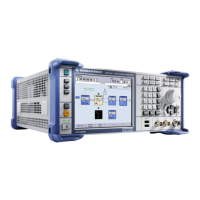Instrument Function
R&S
®
SMBV100A
336Operating Manual 1176.8016.02 ─ 17
frames, for example in the course of base station tests, and yet the signal can still
be generated synchronously. In each frame the base station generates a trigger
which would cause a signal generation restart every time but for the suppression.
Example:
Entering 1000 samples means that after a trigger event, any subsequent trigger signal
is ignored for the space of 1000 samples.
5.9.2.7 Marker Output Signals
The R&S SMBV generates user-definable marker output signals which can be used to
synchronize external instruments. By this means a slot clock or frame clock can be set,
for instance, or the start of a particular modulation symbol can be marked.
Two marker outputs are available.
Marker Connector Location
Markers 1/2 MARKER 1 / 2 BNC connectors rear panel
Marker Modes
Marker mode restart
The generated marker signal is a single "On" pulse. The rising edge of this pulse is
generated at the signal generation start as well as at each subsequent signal restart
time. This marker can be used to monitor the effects of the selected trigger, e.g. trigger
causing restarts of the signal generation.
Marker mode pulse
Periodic marker with consecutive On and Off periods of equal length. The first On
period starts at the beginning of the first generated sample/symbol. The marker fre-
quency is defined by a "Divider". The frequency is derived as follows:
<Frequency> = "Symbol/Sample Rate" / "Divider", respectively
<Frequency> = "Sampling Frequency" / "Divider".
Baseband Signal - Baseband Block

